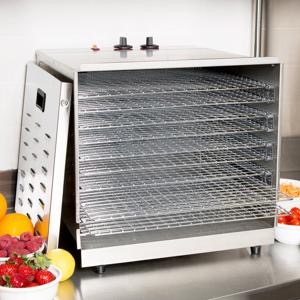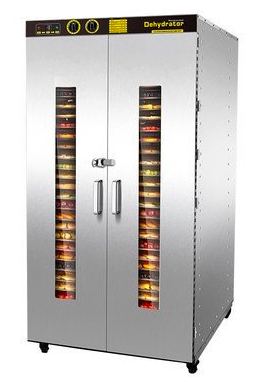
Content Menu
● Introduction
● What is a Heat Pump Dryer?
● Common Causes of Heat Pump Dryer Smells
>> 1. Mold and Mildew Growth
>> 2. Food Residue
>> 3. Electrical Issues
>> 4. Clogged Filters
>> 5. Improper Storage
● How to Maintain Your Heat Pump Dryer
>> 1. Regular Cleaning
>> 2. Proper Ventilation
>> 3. Check for Electrical Issues
>> 4. Monitor Humidity Levels
>> 5. Store Dried Foods Properly
● Benefits of Using Heat Pump Dryers for Food Processing
>> 1. Energy Efficiency
>> 2. Nutritional Preservation
>> 3. Versatility
>> 4. Consistent Results
>> 5. Environmentally Friendly
● Additional Considerations for Optimal Use
>> 1. Choosing Quality Ingredients
>> 2. Pre-Treating Foods
>> 3. Understanding Drying Times
>> 4. Using Dehydration Guides
● Troubleshooting Common Odor Issues
>> 1. Inspect Seals and Gaskets
>> 2. Examine Airflow Paths
>> 3. Conduct Regular Deep Cleanings
● Conclusion
● Frequently Asked Questions
>> 1. What should I do if my heat pump dryer smells like burning?
>> 2. How often should I clean my heat pump dryer?
>> 3. Can I use my heat pump dryer for all types of food?
>> 4. How can I tell if my dried foods have gone bad?
>> 5. What should I do if I find mold inside my heat pump dryer?
Introduction
Food dehydrators are essential tools in the food processing industry, allowing for the preservation of fruits, vegetables, meats, and herbs by removing moisture. Among the various types of food dehydrators, heat pump dryers have gained popularity due to their energy efficiency and ability to maintain the nutritional value of food. However, one common issue that users face is unpleasant odors emanating from these machines. In this article, we will explore the causes of heat pump dryer smells, maintenance tips to prevent them, and the overall benefits of using heat pump dryers for food processing.

What is a Heat Pump Dryer?
A heat pump dryer is a type of dehydrator that uses a heat pump to circulate warm air within a closed system. This method allows for efficient moisture removal while consuming less energy compared to traditional drying methods. The process involves:
- Heat Generation: The heat pump generates heat, which is then circulated through the drying chamber.
- Moisture Removal: As food items are heated, moisture evaporates and is carried away by the airflow.
- Condensation: The moisture is condensed and collected, preventing it from re-entering the drying chamber.
This closed-loop system not only conserves energy but also helps in maintaining the quality and flavor of the dried products.
Common Causes of Heat Pump Dryer Smells
Despite their advantages, heat pump dryers can develop unpleasant odors if not properly maintained. Here are some common causes:
1. Mold and Mildew Growth
Moisture can accumulate in various parts of the dryer if it is not adequately ventilated or cleaned. This creates an ideal environment for mold and mildew to thrive, resulting in musty smells.
2. Food Residue
If food particles or residues are left inside the dryer after use, they can decompose and emit foul odors. It's crucial to clean the drying trays and interior regularly.
3. Electrical Issues
Sometimes, a burning smell may indicate electrical problems within the dryer. Overheating components or faulty wiring can produce unpleasant odors that should be addressed immediately.
4. Clogged Filters
Heat pump dryers come with filters that trap dust and debris. If these filters become clogged, airflow is restricted, leading to overheating and potential smells.

5. Improper Storage
Storing dried foods improperly after processing can also lead to odors. Ensure that dried products are stored in airtight containers to prevent contamination.
How to Maintain Your Heat Pump Dryer
To prevent heat pump dryer smells and ensure optimal performance, regular maintenance is essential. Here are some key maintenance tips:
1. Regular Cleaning
- Interior Cleaning: Wipe down the interior surfaces of the dryer with a damp cloth after each use.
- Tray Cleaning: Remove drying trays and wash them with warm soapy water to eliminate any food residues.
- Filter Maintenance: Clean or replace filters according to the manufacturer's recommendations.
2. Proper Ventilation
Ensure that your heat pump dryer has adequate ventilation to allow moisture to escape efficiently. This will help prevent mold growth and unpleasant smells.
3. Check for Electrical Issues
Regularly inspect electrical components for signs of wear or damage. If you notice any unusual smells or sounds, consult a professional technician immediately.
4. Monitor Humidity Levels
Keep an eye on humidity levels in your drying environment. Excess humidity can contribute to odors in your heat pump dryer.
5. Store Dried Foods Properly
After drying, store your products in airtight containers in a cool, dry place to maintain freshness and prevent odors from developing.
Benefits of Using Heat Pump Dryers for Food Processing
Heat pump dryers offer several advantages over traditional drying methods:
1. Energy Efficiency
Heat pump dryers consume significantly less energy compared to conventional dehydrators because they recycle heat within the system. This not only reduces operational costs but also minimizes environmental impact.
2. Nutritional Preservation
The gentle drying process helps retain more vitamins and minerals in food products compared to high-temperature drying methods. This is particularly important for health-conscious consumers who prioritize nutritional value in their diets.
3. Versatility
These dryers can effectively dry a wide variety of foods, including fruits, vegetables, meats, and herbs. Their adjustable settings allow users to customize drying times and temperatures based on specific food types.
4. Consistent Results
Heat pump dryers provide uniform drying results due to their controlled temperature and airflow settings. This consistency ensures that all food items are dried evenly, reducing the risk of spoilage.
5. Environmentally Friendly
By using less energy and reducing waste through effective moisture removal, heat pump dryers are more environmentally friendly than traditional options. Their design minimizes carbon footprints while maximizing efficiency.
Additional Considerations for Optimal Use
While maintaining your heat pump dryer is crucial for preventing odors, there are additional considerations that can enhance its performance:
1. Choosing Quality Ingredients
The quality of ingredients used in your dehydrator plays a significant role in the final product's taste and smell. Always choose fresh, high-quality foods free from blemishes or spoilage signs.
2. Pre-Treating Foods
Certain foods benefit from pre-treatment before dehydration. For example:
- Soaking fruits in lemon juice or ascorbic acid solutions can prevent browning.
- Blanching vegetables before drying helps preserve color and flavor while reducing microbial load.
These steps can enhance both flavor retention and odor control during the drying process.
3. Understanding Drying Times
Different foods require different drying times based on their moisture content and density. Familiarize yourself with recommended drying times for various products to achieve optimal results without over-drying or under-drying.
4. Using Dehydration Guides
Many manufacturers provide dehydration guides specific to their models that detail ideal temperatures and times for different foods. These guides can be invaluable resources for achieving consistent results while minimizing odors.
Troubleshooting Common Odor Issues
If you encounter persistent odors despite following maintenance practices, consider these troubleshooting steps:
1. Inspect Seals and Gaskets
Check door seals and gaskets for wear or damage that could allow moisture infiltration into the dryer's interior.
2. Examine Airflow Paths
Ensure that airflow paths are clear of obstructions such as dust buildup or misplaced trays which could affect circulation within the unit.
3. Conduct Regular Deep Cleanings
In addition to routine cleaning after each use, schedule deep cleanings every few months where you disassemble components (as per manufacturer guidelines) to thoroughly clean hard-to-reach areas.
Conclusion
Maintaining your heat pump dryer is crucial for preventing unpleasant smells and ensuring optimal performance in food processing. Regular cleaning, proper ventilation, monitoring humidity levels, and storing dried foods correctly will help you enjoy all the benefits these machines offer without the nuisance of odors. By implementing these practices, you can extend the lifespan of your equipment while delivering high-quality dried products to your customers.

Frequently Asked Questions
1. What should I do if my heat pump dryer smells like burning?
If you notice a burning smell from your heat pump dryer, immediately stop using it and check for any electrical issues or overheating components. If necessary, contact a technician for repairs.
2. How often should I clean my heat pump dryer?
It is recommended to clean your heat pump dryer after each use to remove food residues and prevent mold growth. Additionally, check filters monthly for clogs.
3. Can I use my heat pump dryer for all types of food?
Yes! Heat pump dryers are versatile and can effectively dry fruits, vegetables, meats, herbs, and more when used correctly.
4. How can I tell if my dried foods have gone bad?
Signs that dried foods may have spoiled include off smells, changes in color or texture, or visible mold growth on the product.
5. What should I do if I find mold inside my heat pump dryer?
If you discover mold inside your heat pump dryer, clean it thoroughly with a mixture of vinegar and water or a commercial mold remover before using it again to ensure safe operation.
By following these guidelines on maintenance practices tailored specifically for heat pump dryers used in food processing applications while being mindful about odor control measures throughout usage cycles—users will not only enhance their operational efficiency but also ensure high-quality outputs free from undesirable scents!












